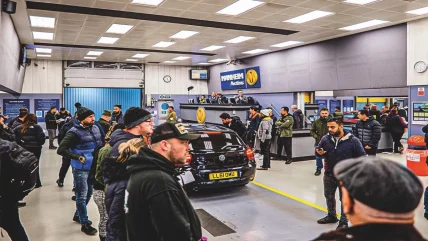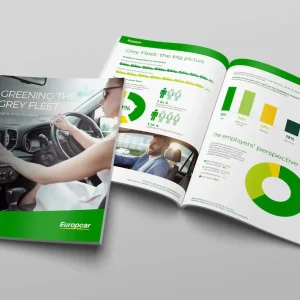
“You can’t beat a physical auction. It allows us to get to know buyers and we can adopt our selling approach accordingly. It enables immediate bidding, strong selling prices, and quick transactions.”
That is the view of Nick Thompson, director of sales at Aston Barclay, which runs all its auctions both physically and online. The firm says it sells around 35-40% of vehicles to online buyers while 60-65% are scooped up by those in the hall, and the figures can vary wildly across the industry.
BCA, for example, ditched physical sales at the pandemic’s onset in March 2020, while most other auction companies went through a digital-only spell then returned to a hybrid format when conditions allowed (assuming they ran physical sales in the first place).
There are cases for and against both. You might not be able to beat a physical auction but, for sheer convenience, online wins hands down. Buyers can bid from anywhere, across multiple locations, and get their hands on vehicles they might not have been able to before the digital age. Ever-increasing confidence around online sales means buyers are happy to bid on certain models without first seeing them in the metal.
“OEMs really do favour pure online, because it’s a fairly fresh product and, nine times out of 10, fairly good condition,” says Philip Nothard, insight director at Cox Automotive, which runs an average of 35 auctions a week both online and physically under its Manheim brand.
Thompson agrees: “Nearly new, fleet, and OEM stock work well online due to vehicles being offered with low mileages and in good condition. Generally, online buyers will bid on and buy the younger NAMA grade one and two vehicles or bid on a very specific car or van for a customer.”
“Our online auctions are held for ex-fleet, lease and premium stock with a service history and with lower mileages,” adds Zoe Sutton, sales director at Motor Auction Group, which runs around six online and four physical auctions a week, and claims to sell three times as many vehicles physically. She adds “Buyers have the confidence to bid on and buy these types of vehicles remotely as they are generally less than four years old and in
good condition.”
However, that confidence is often limited to younger vehicles and to cars. A franchised retail group, for example, will have no qualms about buying a sub-two-year-old car at a closed sale from its affiliated manufacturer. The same cannot be said of a dealer shopping for older cars, commercials, or anything where condition is questionable.
“Commercial vehicles really do support physical auctions,” explains Nothard, “they are the smaller dealers – the one-man bands – and they want to get to that vehicle to check its condition, find out what kind of panelling its had and how good it is.”
“Generally, we sell the older vehicles, those with damage or with a limited service history via this [physical] route,” says Sutton, “dealer part exchanges, voluntary terminations, repossessions and some rental stock, meanwhile, tends to get sold physically.
“We sell a number of budget cars, VTs [voluntary terminations] and repos physically that online auctions struggle to sell, simply because of their age, mileage, condition and lower price point.”
It is worth overlaying these habits with the used car market’s current stock profile. The obvious shortage of vehicles and glut of contract extensions has led to an inevitable increase in the average age and mileage of those vehicles now going under the hammer.
“The average mileage for cars sold physically and virtually at Manheim was 65,000 in the first half of 2019,” says Nothard, “in the first half of this year, it was just over 72,000 – that’s an 8,000-mile/11% increase.
“The average age has gone from 85 months to 106 months – a 25% increase. Some of that is because the retailers are keeping more. higher mileage, older vehicles for retail and not sending them to auction. You’ve also got contract extensions; the average age of a Motability car is now four years rather than three.”
Buyers are not about to turn and run from online auctions because of a few more miles on the clock, but the increasing prevalence of older, well-used vehicles makes a case for physical sales. That, and a lot of buyers were keen to rock up at auction halls after months of cooped-up remote bidding.
“We were one of the first to drive vehicles through the halls again [after lockdown],” says Alex Wright, managing director of Shoreham Vehicle Auctions, which runs three sales a week both physically and online, “buyers, in particular, wanted to come back in, not only to inspect vehicles before bidding, but also to discuss the market with their buyer friends.”
Nonetheless, he concedes that the pandemic fuelled a trend in digital sales, which has been sustained by ongoing stock shortages.
“We have also seen more national buyers buying online since Covid due to the shortages of certain types of stock. It provides for a more competitive marketplace when online and buyers are bidding together.”
Thompson agrees that the lack of stock has pushed more buyers online so they can shop nationally and, like Wright, considers it beneficial.
“Covid. opened the mindset of more buyers to bidding online, which was good for the market. However, based on our vendor and buyer feedback at the end of lockdown, we adopted a hybrid physical/online approach. as opposed to an online-only strategy that some of our rivals have retained.”
Physical sales also allow buyers to bid opportunistically, which they are unlikely to do online. According to Nothard, dealers home in on stock with limited criteria when they shop digitally, which can unintentionally blinker them to worthwhile vehicles that fall outside their usual scope. He claims Manheim’s in-person attendance at auctions has risen for this reason.
“We have seen a continual increase in physical attendance and physical conversions since the pandemic. because of the shortage of vehicles, the retailers see the benefit of going to a physical auction, because they might see something that they wouldn’t have when searching online. In the virtual space, they are searching selective criteria – average age and mileage, based on a portfolio – whereas in a physical environment, they could be sat there waiting for their lot numbers to come up, but they say, ‘you know what? That car looks nice, and it’s not a lot of money. I’ll have a go’.”
He adds that buyers also do both simultaneously – attend a physical sale and bid remotely on one elsewhere – which is said to give them the buzz from the hall along with the breadth of online stock available.
“As soon as there is an online presence you can hit multiple sales in multiple locations very efficiently. The physical aspect still allows you to do that, because what we see is people in a physical environment buying online at another sale. Just because they are physically in that auction, doesn’t mean they are not necessarily buying virtually somewhere else on their iPad.”
“There’s a networking element to that physical environment which still exists,” he explains, “the dealers still want to go and see people and see who is actually bidding. This is a fairly unique one that nobody really talks about, but the physical buyer adds confidence to the virtual buyer, because they can see who’s in the hall. all the online buyer sees is the videos, the description and the virtual images, but the one in the hall looks and thinks, ‘if that car has five people bidding, it must be OK’.
“I’ve been there – physically in a hall – when a person has gone up to the auctioneer and asked about service history on a Tesla. suddenly, it creates this conversation, where the auctioneer says, ‘apologies, you don’t get a service history on a Tesla’. It creates a slightly different dynamic by having both physical and virtual which is what we are starting to see play out now.”
Supported by:






